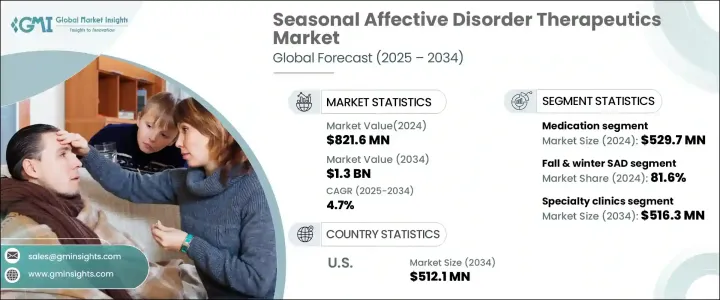
세계의 계절성 정서 장애(SAD) 치료 시장은 2024년에 8억 2,160만 달러로 평가되며, 2025-2034년에 CAGR 4.7%로 성장할 것으로 예측됩니다.
SAD 치료에는 광선 요법, 항우울제, 심리치료, 특히 가을에서 겨울로 넘어가는 계절적 변화로 인한 기분 장애를 관리하기 위한 혁신적인 개입이 포함되며, 효과적이고 저렴한 환자 친화적인 치료 옵션에 대한 수요가 증가하고 있습니다. 개선된 광치료 장비 및 서방형 항우울제와 같은 치료법의 발전은 치료의 효과를 높이고 시장 성장에 기여하고 있습니다. 또한 AI 기반 기분 추적 앱과 원격 정신의학 플랫폼과 같은 디지털 건강 툴은 개인화된 치료 계획을 가능하게 하고 있습니다. 행동치료와 생활습관 변화를 통합한 이러한 복합 치료 접근법은 점점 더 많이 채택되고 있습니다. 이러한 총체적 접근은 근본적인 원인을 해결할 뿐만 아니라 환자의 전반적인 행복감을 향상시킵니다.

시장은 치료 유형, 장애 유형, 최종 용도별로 분류됩니다. 2024년 5억 2,970만 달러 규모의 약물 치료 부문에는 선택적 세로토닌 재흡수 억제제(SSRI), 노르에피네프린-도파민 재흡수 억제제(NDRI), 모노아민 산화효소 억제제(MAOI), 기타 약물이 포함됩니다. MAOI), 기타 약물이 포함됩니다. 플루옥세틴, 셀트랄린과 같은 SSRI는 생화학적 균형을 통해 기분을 조절함으로써 우울증 증상 관리에 중요한 역할을 합니다. 서방형 제제와 같은 기술 혁신은 환자의 순응도를 개선하고 부작용을 줄입니다. 또한 항우울제와 멜라토닌 수용체 작용제와 같은 보완적 치료제의 병용은 치료 옵션을 다양화하여 시장 확대를 지원하고 있습니다. 약물유전체학에 의해 추진되는 맞춤형 의료는 치료 효과를 높이고 시장을 더욱 촉진할 것입니다.
| 시장 범위 | |
|---|---|
| 시작연도 | 2024년 |
| 예측연도 | 2025-2034년 |
| 시작 금액 | 8억 2,160만 달러 |
| 예상 금액 | 13억 달러 |
| CAGR | 4.7% |
장애 유형에 따라 시장은 가을-겨울 SAD와 봄-여름 SAD로 나뉩니다. 일조시간이 짧은 시기에 SAD의 유병률이 높아지기 때문에 2024년 시장 점유율은 가을-겨울 SAD가 81.6%를 차지했습니다. 일조시간의 감소는 일주기 리듬과 세로토닌 생성을 방해하여 우울증 증상을 유발합니다. 이 분야는 이러한 계절성 기분장애 유발 요인에 대응할 수 있도록 조정된 첨단 광치료 기기, 개선된 항우울제, 인지행동치료의 개발로 혜택을 누리고 있습니다. 계절성 기분장애에 대한 인식이 높아지고 병용요법의 채택이 확대되면서 이 부문의 지속적인 성장에 기여하고 있습니다.
최종사용자별로 시장은 병원, 전문 클리닉, 홈케어 환경, 기타 최종사용자로 분류됩니다. 전문 클리닉이 가장 큰 시장 점유율을 차지하고 있으며, 2034년에는 5억 1,630만 달러에 달할 것으로 예측됩니다. 이러한 클리닉은 고급 진단 및 치료 절차를 통해 전문적인 치료를 제공하고, 광치료 및 약리학적 개입과 같은 맞춤형 치료를 원하는 환자들을 대상으로 합니다. 전문 클리닉은 기분 추적 기술 및 원격 정신의학 서비스를 활용한 통합적 치료를 제공함으로써 그 존재감을 높이고 있습니다. 정신건강에 대한 인식 증가, 일반 개업의들의 소개, 전문적인 치료를 선호하는 환자 등이 전문 클리닉의 성장을 촉진하고 있습니다.
북미의 경우, 미국의 계절성 정서장애(SAD) 치료 시장은 연평균 4.7% 성장하여 2034년에는 5억 1,210만 달러 규모에 달할 것으로 예측됩니다. 이러한 성장 요인으로는 정신건강에 대한 인식 증가, SAD의 높은 유병률, 고급 의료 인프라의 가용성 등이 있습니다. 광치료 장비의 보급, 정신건강에 대한 상환 정책, 원격 정신의학 플랫폼의 발전은 조기 진단을 강화하고 치료 결과를 개선하여 이 지역 시장 성장을 지원하고 있습니다.
The Global Seasonal Affective Disorder Therapeutics Market was valued at USD 821.6 million in 2024 and is anticipated to grow at a 4.7% CAGR from 2025 to 2034. Rising cases of SAD are driving demand for effective, affordable, and patient-friendly treatment options. SAD treatments include light therapy, antidepressants, psychotherapy, and innovative interventions aimed at managing mood disorders triggered by seasonal changes, particularly during fall and winter. Advancements in treatment methods, such as improved light therapy devices and extended-release antidepressants, are increasing the efficacy of therapies, contributing to market growth. Additionally, digital health tools such as AI-powered mood tracking apps and telepsychiatry platforms are enabling personalized treatment plans. These combined treatment approaches, which integrate behavioral therapy with lifestyle changes, are witnessing growing adoption. This holistic approach not only addresses the underlying causes but also enhances overall patient well-being.

The market is segmented by treatment type, disorder type, and end use. Based on treatment type, the market includes medication and therapy segments. The medication segment, which accounted for USD 529.7 million in 2024, includes selective serotonin reuptake inhibitors (SSRIs), norepinephrine-dopamine reuptake inhibitors (NDRIs), monoamine oxidase inhibitors (MAOIs), and other medications. SSRIs, such as fluoxetine and sertraline, play a vital role in managing depressive symptoms by regulating mood through biochemical balance. Innovations such as extended-release formulations improve patient adherence and reduce side effects. Furthermore, combining antidepressants with complementary treatments, such as melatonin receptor agonists, is diversifying treatment options and supporting market expansion. Personalized medicine, driven by pharmacogenomics, enhances treatment efficacy and further propels the market.
| Market Scope | |
|---|---|
| Start Year | 2024 |
| Forecast Year | 2025-2034 |
| Start Value | $821.6 Million |
| Forecast Value | $1.3 Billion |
| CAGR | 4.7% |
By disorder type, the market is divided into fall & winter SAD and spring & summer SAD. The fall & winter SAD segment held an 81.6% market share in 2024 due to the higher prevalence of SAD during periods with shorter daylight hours. Reduced sunlight disrupts circadian rhythms and serotonin production, leading to depressive symptoms. This segment benefits from the development of advanced light therapy devices, improved antidepressants, and cognitive-behavioral therapies tailored to address these seasonal mood triggers. Increased awareness of seasonal mood disorders and the growing adoption of combination therapies contribute to the continued dominance of this segment.
By end use, the market is categorized into hospitals, specialty clinics, homecare settings, and other end users. Specialty clinics accounted for a significant market share and are expected to reach USD 516.3 million by 2034. These clinics offer specialized care with advanced diagnostic and treatment procedures, catering to patients seeking tailored therapies such as light therapy and pharmacological interventions. Specialty clinics provide integrated care using mood-tracking technologies and telepsychiatry services, contributing to their growing prominence. Increased awareness of mental health, referrals from general practitioners, and patient preference for specialized care are driving the growth of specialty clinics.
In North America, the US seasonal affective disorder therapeutics market is projected to grow at a 4.7% CAGR, reaching USD 512.1 million by 2034. Factors contributing to this growth include rising mental health awareness, high prevalence of SAD, and the availability of advanced healthcare infrastructure. Widespread adoption of light therapy devices, reimbursement policies for mental health, and advancements in telepsychiatry platforms also enhance early diagnosis and improve treatment outcomes, supporting market growth in the region.